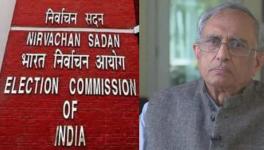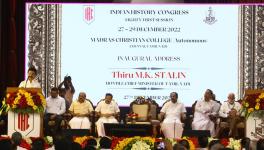On The Ball | Cricket’s Big Technology Problem

R Ashwin’s run out of Jos Buttler in the Indian Premier League (IPL) game between Kings XI Punjab and Rajasthan Royals sparked an age old debate about the spirit of the game. (Pic: IANS)
Season 12 of the Indian Premier League is barely a week old, but the controversy meter is already rapidly adding to the searing heat wave sweeping across the country. No non-honorary local has featured thus far in Chennai Super Kings’ roaring start to the defence of their title. The talking points, however, have been provided by two true-blues Chennaites.
R Ashwin’s run-out at the bowler’s end of a backing-up Jos Buttler evoked the age-old spirit versus rule debate, one that is unlikely to be settled anytime soon. In its collective wisdom, the Marylebone Cricket Club held after much deliberation that the Indian off-spinner cocked a snook at the spirit of the game, while acknowledging that the England batsman ought not to have left his crease till the ball was ‘on its way down the pitch’. The unanswered question is whether Ashwin had contravened the law. After all, bowlers/fielders appeal for just about everything these days, and the ultimate decision-making power rests with the officials. If Ashwin’s appeal was without basis, then third umpire Bruce Oxenford erred in ruling Buttler out. If the Buttler dismissal was within the rules, then the matter should end there and Ashwin be spared the moral lecture. Or maybe one is being too naïve.
Read More | IPL Form Will Matter for World Cup Selection: BCCI Goes for a Reverse Hit
There were no such grey areas in Bangalore the other night, when it was clear as crystal – long after the final denouement and the customary handshakes – that umpire S Ravi had failed to spot a no-ball that could have altered the destination of the face-off between Royal Challengers Bangalore and Mumbai Indians. RCB needed seven off the last delivery of the match, from Lasith Malinga to Shivam Dube. The Sri Lankan white-ball skipper sent down a middle-stump full-toss that the batsman smashed to long-on, but because he was so distraught that he hadn’t hammered the six that would have necessitated a Super Over, he didn’t take the single that was on offer.
Rohit Sharma’s MI celebrated, and Virat Kohli’s RCB were just reconciling to their second loss on the trot, when a 28,000-strong crowd that had gone silent suddenly found its voice, angry and censuring. The giant screen had just flashed a replay of Malinga’s left foot landing well in front of the popping crease. Everyone at the stadium, including Ravi, knew it was a no-ball; no one could do anything about it because the stumps had been plucked out, the game had been called won and lost, and the players were lining up to shake hands at the edge of the boundary.
Read More | On the Ball: Numbers Finally Catch Up With Test Cricket
Now, there is no gainsaying what might have happened had Ravi spotted the no-ball and called it in the first place. It is fair to assume that the dawdling Dube would have been pulled through for a single by the gallant AB de Villiers, prancing at the non-striker’s end with 70 to his name. That would have brought the equation down to five for victory from the resultant free-hit ball, or four for the Super Over. Who knows?
Unsurprisingly, daggers were drawn and aimed at Ravi, India’s representative in the ICC Elite panel of umpires and with a growing reputation as among the best in the business. Interestingly, he was at the receiving end of both Kohli and Rohit’s ire. In fact, after the MI skipper’s press conference where he stopped just short of seeking sanctions against erring officials, it was hard to believe that his team had actually come out smiling. But one could see where both Kohli and Rohit were coming from.
At the best of times, it was a horrible mistake from the seasoned Ravi. As it is, Malinga has a history of flirting with the line, which belongs to the umpire. Additionally, so much hinged on that one delivery that it was imperative that the official summoned greater powers of concentration. Malinga’s wasn’t a marginal transgression; at the time or release, his left foot was nearly an inch in front of the crease. Even given the challenges umpires encounter in looking down to check the front foot, then looking up to see where the ball has landed and what action is transpiring at the other end, there simply was no excuse for Ravi missing the non-legality of said delivery.
Read More | Gautam Gambhir Joins BJP; Could Contest Lok Sabha Elections
That’s now passed into history. This isn’t the first no-ball a standing umpire has failed to spot, and under the convention as it exists, it most certainly won’t be the last. But, like Ashwin’s running out of Buttler could trigger a reworking of the Laws, if Ravi’s oversight that should not have been catalyses a greater involvement of technology in decision-making, then some good will still have come out of this forgettable and avoidable misadventure.
Cricket has a long, and inexplicable, history of placing its faith in half-measures. While on the one hand technology is eulogized as the tool that helps augment the decision-making process, the reluctance to embrace it to the fullest extent possible is both mysterious and disappointing. Umpires are happy to throw even clear-cut line decisions upstairs for whatever reason, but the law-makers continue to offer a deaf ear to strident calls for the television umpire to watch out for foot-fault no-balls. They might believe that will further undermine the authority of the men in the black coats, but better that than making an irreversible boohoo in full public glare. Because a call of no-ball can’t be overturned even in the face of irrefutable evidence, umpires are increasingly leaning towards letting marginal no-ball calls slide by in the security that they can always refer them in the event of a dismissal. How that is not self-defeating beggars the imagination.
The time has now come to empower the third umpire even more, and make him responsible for no-ball scans. That will allow the standing umpire to focus in front of him; given the speed at which TV replays are being facilitated, it won’t take more than a second or three for the third umpire to assess the legality of a delivery and convey the same to his colleague on the field. It will enhance team work, but more crucially, it will eliminate the kind of howlers precisely for which cricket has turned to technology.
Cricket has largely been a reactive sport, in more ways than one. A golden opportunity for pro-active reaction has presented itself through glaring human error. It’s time to seize the moment. Carpe diem, but with an eye on the future, too.
Kaushik is a veteran cricket writer who has reported on over 100 Tests. He co-authored VVS Laxman's autobiography '281 and Beyond'.
Get the latest reports & analysis with people's perspective on Protests, movements & deep analytical videos, discussions of the current affairs in your Telegram app. Subscribe to NewsClick's Telegram channel & get Real-Time updates on stories, as they get published on our website.
























